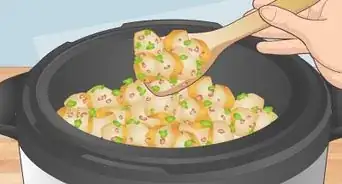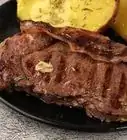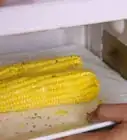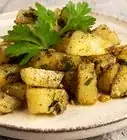This article was co-authored by wikiHow Staff. Our trained team of editors and researchers validate articles for accuracy and comprehensiveness. wikiHow's Content Management Team carefully monitors the work from our editorial staff to ensure that each article is backed by trusted research and meets our high quality standards.
The wikiHow Culinary Team also followed the article's instructions and verified that they work.
This article has been viewed 1,231,528 times.
Learn more...
Baked potatoes are an easy and inexpensive side dish to make. Potatoes are a good source of vitamin C, fiber, potassium, and manganese.[1] Because potatoes are so versatile, there are numerous ways to cook them. Below are several easy ways to make baked potatoes. (Sticklers beware, not all of the methods involve traditional "baking.") Pick the method that looks most enticing to you, or experiment a little!
Ingredients
- Baking potatoes, 6 to 8 ounces each — russet or red potatoes, depending on personal taste
- Sour cream (optional)
- Chives (optional)
- Olive oil (optional)
- Butter (optional)
- Cheese (optional)
- Dill (optional)
Steps
Preparation
-
1Scrub potatoes and rinse well with cold water.
-
2Remove excess moisture by drying potatoes with a clean tea towel or white paper towels, if baking in a conventional oven.Advertisement
-
3Remove the "eyes" from the potatoes.
-
4Cut off any bruised or bad spots, if required.
-
5Pierce the potatoes once or twice with a fork. This will allow for faster, more even cooking.
Method One: Conventional Oven
-
1Rub the potatoes with olive oil to coat evenly. (optional). Season with salt and pepper. Place the potatoes on a baking tray or roasting dish (optional). (Some people prefer to put the potato directly onto the wire rack.)
-
2Bake potatoes at 425 °F (218 °C) for 45 to 60 minutes.[2] [3] Potatoes are done when they can be pierced easily with a fork.
- Potatoes may also be baked at lower temperatures for longer times. This process tends to give the outside of the spud a crisper skin.[2] 350 °F (177 °C) for approximately 90 minutes or 375 °F (191 °C) for approximately 75 minutes is a good guideline.
- Cooking times will vary. Not all potatoes are uniform in size and mass, making these cooking times a guideline, not a rule. Perform the fork test to figure out if the potato has reached the doneness you want.
-
3Season and garnish as necessary. Some classic combinations include:
- Sour cream and chive
- Butter and salt
- Cheese
Method Two: Aluminum Foil
-
1Season the potatoes with olive oil, salt and pepper (optional). If you're not going to do anything with the baked potato after it's cooked, seasoning it with olive oil, salt and pepper might be a good idea.
-
2Wrap the potatoes in aluminum foil. Aluminum foil is a good conductor of heat, meaning that the cooking time on baked potatoes wrapped in aluminum foil will probably go down. If you like baked potatoes with crispy skins, however, look out: wrapping in aluminum foil creates a potato with skin that is more steamed than crispy.[4]
-
3Bake at 425 °F (218 °C) for ~45 to 60 minutes, or 400 °F (204 °C) for 60 to 70 minutes. Slower-cooked baked potatoes often have a creamier center.
- Check the potato for doneness slightly before you think it may be finished cooking. Because the aluminum foil accelerates the cooking, you may want to check early to avoid an overdone potato.
-
4Garnish as necessary.
Method Three: Microwave
-
1Place the potatoes in a microwave-safe dish and microwave on high for 5 minutes.
-
2Turn the potatoes over and microwave for an additional 3 to 5 minutes.
-
3Check for doneness. If potato is still not fully cooked, continue microwaving potato in 1 minute intervals until fully cooked.
-
4Garnish as necessary.
Method Four: Slow Cooker
-
1Scrub potatoes but do not dry. A little moisture will make for a better baked potato after it has finished cooking.
-
2Place in slow cooker, cover, and cook on low for 6 to 8 hours or until tender. This method will produce the softest-skinned, lightest potato. Cooking at very low heat for longer times will minimize the risk of overcooking.
-
3Garnish as necessary.
Community Q&A
-
QuestionShould the potato be poked with a fork while wrapped in foil?
 Community AnswerYou can do that, but it's better to pierce the potato prior to wrapping it in foil. This allows for the potato to cook more evenly.
Community AnswerYou can do that, but it's better to pierce the potato prior to wrapping it in foil. This allows for the potato to cook more evenly. -
QuestionCan I use any size of potato?
 Community AnswerWhen baking potatoes, size is never the key. Any size will work, but bigger potatoes may take longer to fully bake than smaller potatoes.
Community AnswerWhen baking potatoes, size is never the key. Any size will work, but bigger potatoes may take longer to fully bake than smaller potatoes. -
QuestionIs it very important to remove the eyes?
 Community AnswerNo. It gives more texture to the potato. The eyes are edible and won't hurt you.
Community AnswerNo. It gives more texture to the potato. The eyes are edible and won't hurt you.
Things You'll Need
- Vegetable scrubbing brush
- Paring knife to remove potato eyes or bruises
References
- ↑ http://nutritiondata.self.com/facts/vegetables-and-vegetable-products/2770/2
- ↑ 2.02.1http://www.guardian.co.uk/lifeandstyle/wordofmouth/2010/nov/04/how-cook-perfect-jacket-potato
- ↑ http://www.thekitchn.com/how-to-bake-a-potato-three-eas-157073
- ↑ https://www.thekitchn.com/old-habits-baked-potatoes-wrap-68473
- Adapted from Crockery Cookery and personal cooking experience.
About This Article
To bake potatoes, first scrub the potatoes and rinse them in cold water. Pat them dry and cut off any bruised or discolored spots. Then, pierce the potatoes with a fork for faster cooking. In an oven, bake the potatoes at 425 °F (220°C) for 45-60 minutes. You also wrap them in aluminium foil to shorten your cooking time since it acts a heat conductor. For fast baked potatoes, place the washed and pierced potatoes in a microwave-safe dish. Cook for 5 minutes on each side and enjoy!




















































